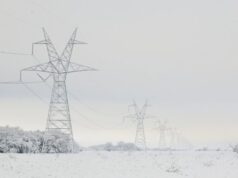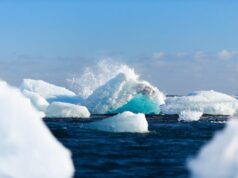During glacial periods, the sea level falls, because vast quantities of water are stored in the massive inland glaciers. To date, however, computer models have been unable to reconcile sea-level height with the thickness of the glaciers. Using innovative new calculations, a team of climate researchers led by the Alfred Wegener Institute has now managed to explain this discrepancy. The study, which was recently published in the journal Nature Communications, could significantly advance research into our planet’s climate history.
During transitions from glacials to interglacials, the glaciers on Greenland and in North America and Europe wax and wane over tens of thousands of years. The more water that is stored in the mighty glaciers, the less there is in the oceans—and the lower the sea level is. Climate researchers are now investigating to what extent the glaciers could melt in the coming centuries due to anthropogenic climate change, and how much the sea level would rise as a result. To do so, they’re look back into the past. If they can understand the ice growth and melting during past glacials and interglacials, they’ll be able to draw valuable conclusions about the future.
The ‘missing ice problem’
However, reconstructing the distant past is no mean feat, because the glaciers’ thickness and sea level can’t be measured directly. Accordingly, climate researchers have to painstakingly gather evidence that they can then use to form a picture of the past. The problem: different pictures emerge, depending on the types of evidence collected. We can’t say with absolute certainty what the situation was actually like ten thousand years ago. This ‘missing ice problem’ remained unsolved for many years. It describes the incongruity of two different scientific approaches that sought to reconcile sea-level height and glacier thickness at the peak of the last glacial, ca. 20,000 years ago. A team of climate experts led by Evan Gowan from the Alfred Wegener Institute, Helmholtz Centre for Polar and Marine Research (AWI) in Bremerhaven has now solved the problem using a new method. “It looks like we’ve found a new way to reconstruct the past as far back as 80,000 years,” says Dr. Gowan, who has been investigating the problem for roughly a decade. These findings have now been published in the journal Nature Communications.
Sediment analysis versus global climate modeling
Find your dream job in the space industry. Check our Space Job Board »
The ‘missing ice problem’ is based, on the one hand, on an analysis of sediments from core samples collected from the seafloor in the tropics. These contain traces of corals that can still tell us today to what extent the sea level rose or fell over the millennia. Why? Because corals only live in well-lit waters near the ocean’s surface. The sediment cores indicate that 20,000 years ago, the sea level in the tropics implied that sea level was roughly 130 meters lower than it is today. On the other hand, previous models have suggested that the glacial masses weren’t large enough 20,000 years ago to explain such a low sea level. To be more precise, for the sea level to be that low, on a global scale an additional volume of water with twice the mass of the Greenland Ice Sheet would have to have been frozen; hence the ‘missing ice problem’.
Understanding glacial behavior
With his new method, Gowan has now reconciled sea level and glacier mass: according to his calculations, the sea level at the time was ca. 116 meters lower than it is today. Based on his approach, there is no discrepancy in terms of glacier mass. Unlike the previous global model, Gowan closely examined the geological conditions in the glaciated regions: how steep was the ice surface? Where did glaciers flow? How much did the rocks and sediment at the base of the ice resist ice flow? His model considers all of these aspects. It also takes into account to what extent the ice sheet pressed down on the Earth’s crust in the respective areas. “That depends on how viscous the underlying mantle was,” Gowan explains. “We base our calculations on different mantle viscosities, and therefore arrive at different ice masses.” The resulting ice masses can now be reconciled with the sea level without any discrepancy.
The established model is flawed
The recent article by Gowan and his team critically re-examines the long-established scientific method used to estimate glacier masses: the oxygen isotope method. Isotopes are atoms of the same element that have different numbers of neutrons and therefore different masses. Oxygen, for example, has a lighter 16O isotope, and a heavier 18O isotope. According to conventional theory, the lighter 16O evaporates from the oceans, while the heavier 18O remains in the water. Accordingly, during glacials, when large inland glaciers form and the volume of water in the oceans decreases, the 18O concentration in the oceans should increase. However, as has been shown, this established model produces discrepancies when it comes to reconciling sea-level height and glacier masses for the period 20,000 years ago and earlier. “For many years, the isotope model has been frequently used to determine the ice volume of glaciers up to several million years ago. Our study calls into question the reliability of this method,” says Gowan. His aim is to now use his new method to improve the traditional oxygen isotope method.
Provided by: Alfred Wegener Institute
More information: Evan J. Gowan et al. A new global ice sheet reconstruction for the past 80 000 years. Nature Communications (2021). DOI: 10.1038/s41467-021-21469-w
Image: Ice Surface Elevation — 20,000 Years ago.
Credit: Alfred-Wegener-Institut / Evan Gowan











